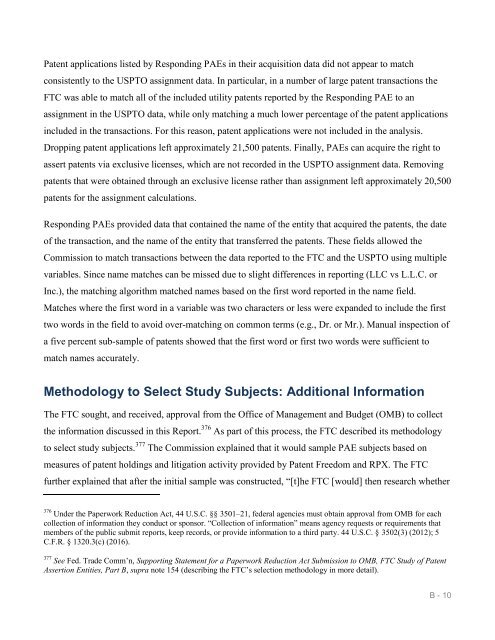Create successful ePaper yourself
Turn your PDF publications into a flip-book with our unique Google optimized e-Paper software.
<strong>Patent</strong> applications listed by Responding PAEs in their acquisition data did not appear to match<br />
consistently to the USPTO assignment data. In particular, in a number of large patent transactions the<br />
FTC was able to match all of the included utility patents reported by the Responding PAE to an<br />
assignment in the USPTO data, while only matching a much lower percentage of the patent applications<br />
included in the transactions. For this reason, patent applications were not included in the analysis.<br />
Dropping patent applications left approximately 21,500 patents. Finally, PAEs can acquire the right to<br />
assert patents via exclusive licenses, which are not recorded in the USPTO assignment data. Removing<br />
patents that were obtained through an exclusive license rather than assignment left approximately 20,500<br />
patents for the assignment calculations.<br />
Responding PAEs provided data that contained the name of the entity that acquired the patents, the date<br />
of the transaction, and the name of the entity that transferred the patents. These fields allowed the<br />
Commission to match transactions between the data reported to the FTC and the USPTO using multiple<br />
variables. Since name matches can be missed due to slight differences in reporting (LLC vs L.L.C. or<br />
Inc.), the matching algorithm matched names based on the first word reported in the name field.<br />
Matches where the first word in a variable was two characters or less were expanded to include the first<br />
two words in the field to avoid over-matching on common terms (e.g., Dr. or Mr.). Manual inspection of<br />
a five percent sub-sample of patents showed that the first word or first two words were sufficient to<br />
match names accurately.<br />
Methodology to Select Study Subjects: Additional Information<br />
The FTC sought, and received, approval from the Office of Management and Budget (OMB) to collect<br />
the information discussed in this Report. 376 As part of this process, the FTC described its methodology<br />
to select study subjects. 377 The Commission explained that it would sample PAE subjects based on<br />
measures of patent holdings and litigation activity provided by <strong>Patent</strong> Freedom and RPX. The FTC<br />
further explained that after the initial sample was constructed, “[t]he FTC [would] then research whether<br />
376<br />
Under the Paperwork Reduction Act, 44 U.S.C. §§ 3501–21, federal agencies must obtain approval from OMB for each<br />
collection of information they conduct or sponsor. “Collection of information” means agency requests or requirements that<br />
members of the public submit reports, keep records, or provide information to a third party. 44 U.S.C. § 3502(3) (2012); 5<br />
C.F.R. § 1320.3(c) (2016).<br />
377<br />
See Fed. Trade Comm’n, Supporting Statement for a Paperwork Reduction Act Submission to OMB, FTC Study of <strong>Patent</strong><br />
<strong>Assertion</strong> Entities, Part B, supra note 154 (describing the FTC’s selection methodology in more detail).<br />
B - 10


